Lunar & Solar Pollen Coronae, Russia - OPOD
Lunar & Solar Pollen Coronae: A Spectacular Natural Phenomenon
Pollen coronae, a fascinating atmospheric optics phenomenon, have been captured in stunning images by Sergei Antipov in Russia. Located approximately 50km from Murom, a historical city in Vladimir Oblast, these mesmerizing images showcase the beauty of nature's intricate patterns. The captivating lunar and solar pollen coronae are created by the scattering of light waves by pollen grains, resulting in the formation of multiple rings and elongated shapes.
The Delicate Dance of Light and Pollen
Pollen coronae, similar to their cloud water droplet counterparts, occur when individual pollen grains scatter light waves. This scattering process leads to the creation of a diffraction pattern projected onto the sky. Unlike circular coronae, pollen coronae exhibit non-circular shapes with several well-defined rings. The unique shape arises from the alignment of non-spherical pollen grains due to aerodynamic drag. The constant size of these grains contributes to the presence of multiple rings within the corona.
Birch and Pine: Nature's Contributors to Pollen Coronae
In the region captured by Sergei Antipov, Spring brings forth a vibrant display of pollen coronae. The birch trees release their pollen early in May, while the pine trees bloom towards the end of the month. Each type of pollen contributes its own distinct characteristics to the coronae:
- Birch pollen: With its less asymmetric shape, birch pollen produces smoother coronal rings.
- Pine pollen: Equipped with air sacs for wind dispersal, pine pollen grains align themselves in a way that creates a sharp diffraction pattern with spots of higher intensity. This alignment results in more elongated and lumpy rings within the corona.
Unveiling the Splendor: Sergei Antipov's Captivating Images
Sergei Antipov's photographs offer a glimpse into the enchanting world of lunar and solar pollen coronae. In his May 5th images, the moon's gentle rays cast a delicate elongated corona with two or even three rings in certain areas. The near sunset solar corona, captured on the same day, showcases the mesmerizing beauty of pollen coronae against the backdrop of a setting sun.
On May 26th, Sergei's lens captures more breathtaking coronae. These later coronae are likely attributed to pine pollen, as they exhibit elongated and lumpy rings. The images vividly display the well-defined bright spots within the pine corona, showcasing the sharp diffraction pattern created by the aligned pollen grains.
A Glimpse into the Past: Sergei Antipov's Image from 2014
Sergei Antipov's collection of images includes a captivating shot from 2014, providing a timeless perspective on the beauty of pollen coronae. This particular image reveals the well-defined bright spots within a pine corona, highlighting the intricate details of nature's masterpiece.
Conclusion
The captivating lunar and solar pollen coronae captured by Sergei Antipov in Russia offer a glimpse into the wonders of atmospheric optics. These stunning images showcase the unique shapes and multiple rings formed by the scattering of light waves by pollen grains. With birch and pine pollen contributing their own distinct characteristics to the coronae, each Spring brings forth a symphony of nature's patterns. Sergei Antipov's photographs serve as a testament to the delicate dance between light and pollen, reminding us of the mesmerizing beauty that surrounds us in the natural world.
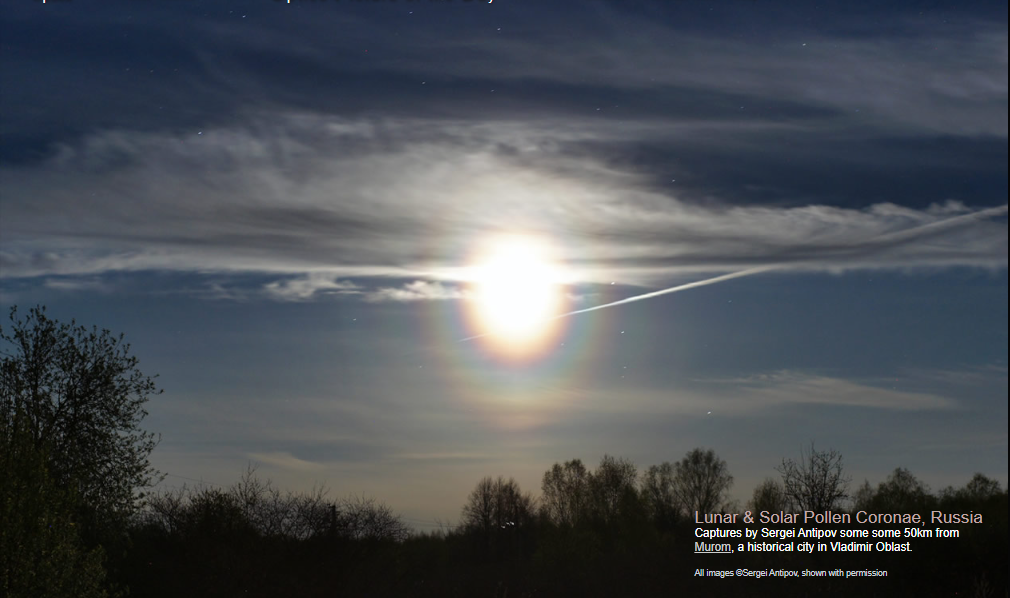
Lunar & Solar Pollen Coronae, Russia
Captures by Sergei Antipov some some 50km from Murom, a historical city in Vladimir Oblast.
All images ©Sergei Antipov, shown with permission
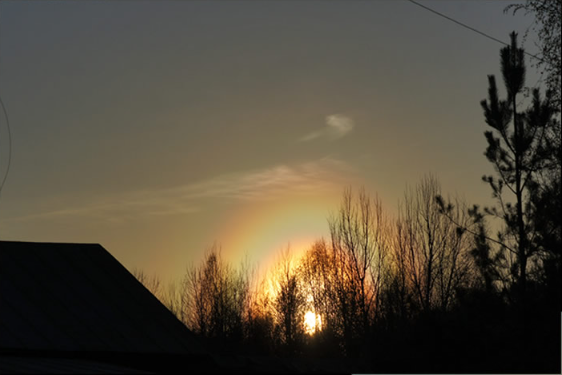
The moon’s gentle rays create a delicate elongated corona with two and perhaps even three rings in places. Sergei took this and the accompanying near sunset solar corona on May 5, ’15. More coronae from May 26th are below. Each Spring the region has regular coronae. Birch releases its pollen early in May and pine blooms towards the month’s end.
Pollen coronae, like the more familiar ones from cloud water droplets, arise when the grains individually scatter light waves. The outgoing waves are in-phase in some directions and out-of-phase in others. A sky projected diffraction pattern results.
Pollen coronae are characteristically non circular and of several well defined rings. The shape comes from the non-spherical grains aligned by aerodynamic drag. The many rings from their constancy of size.
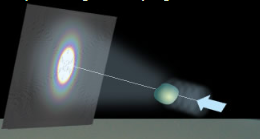
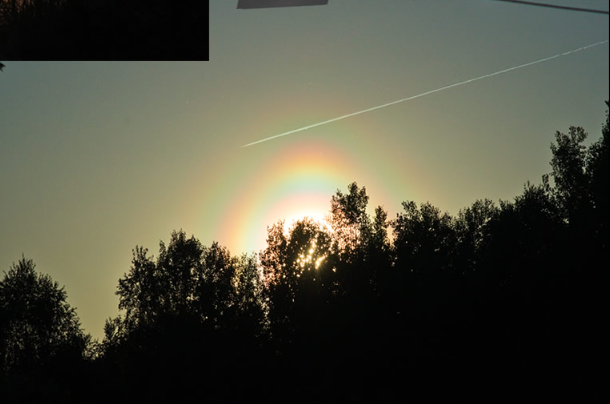
Above:
Near sunset on May 5. Smooth rings.
Right:
May 26. More elongated lumpy rings. This later corona is probably from pine.
Pine pollen grains have air sacs to help wind dispersal. The sacs also align the grains to give a sharp diffraction pattern with spots of higher intensity. The earlier birch pollen is less asymmetric and its coronal rings are smoother.
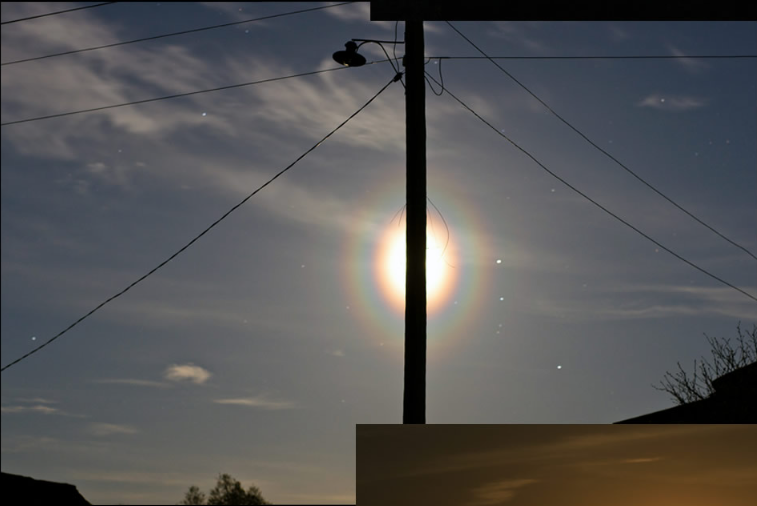
This May 5 lunar shot shows well the corona's elongation.
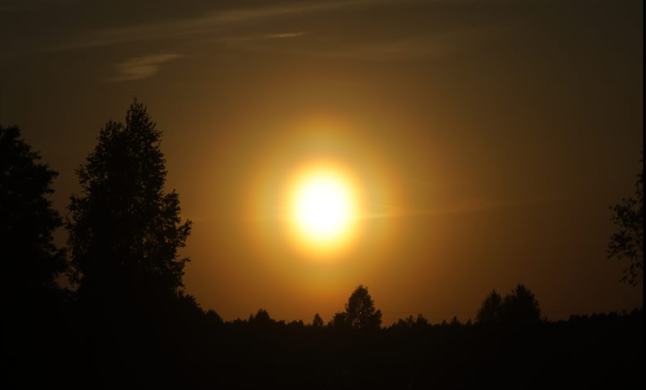
One of Sergei's images from 2014.
Here the bright spots of a pine corona are well defined.
Note: this article has been automatically converted from the old site and may not appear as intended. You can find the original article here.
Reference Atmospheric Optics
If you use any of the definitions, information, or data presented on Atmospheric Optics, please copy the link or reference below to properly credit us as the reference source. Thank you!
-
<a href="https://atoptics.co.uk/blog/lunar-solar-pollen-coronae-russia-opod/">Lunar & Solar Pollen Coronae, Russia - OPOD</a>
-
"Lunar & Solar Pollen Coronae, Russia - OPOD". Atmospheric Optics. Accessed on April 24, 2024. https://atoptics.co.uk/blog/lunar-solar-pollen-coronae-russia-opod/.
-
"Lunar & Solar Pollen Coronae, Russia - OPOD". Atmospheric Optics, https://atoptics.co.uk/blog/lunar-solar-pollen-coronae-russia-opod/. Accessed 24 April, 2024
-
Lunar & Solar Pollen Coronae, Russia - OPOD. Atmospheric Optics. Retrieved from https://atoptics.co.uk/blog/lunar-solar-pollen-coronae-russia-opod/.